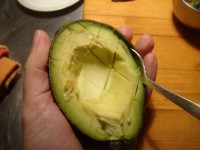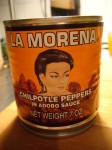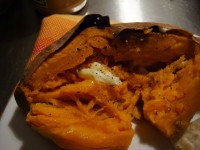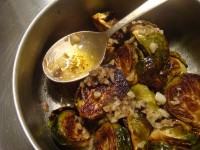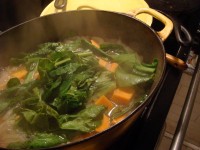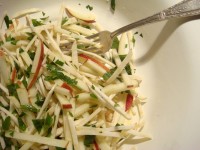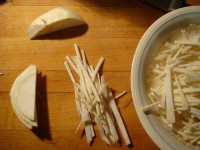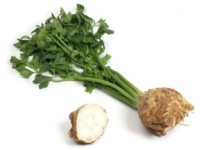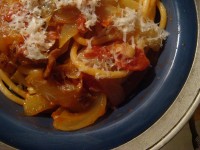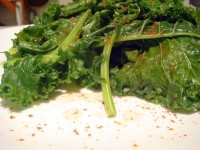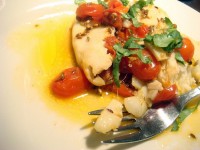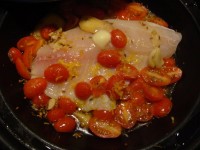Podcast: Play in new window | Download
This week, it’s a really tasty version of the much-maligned meatloaf, along with some delicate little potatoes and some sturdy greens. It’s a very meat-and-potatoes kind of dinner, but satisfying nonetheless. And you can make a delicious cold meatloaf sandwich with the leftovers.
Shopping list
-
1 pound mixed ground beef, pork and veal, sometimes labeled “meatloaf mix” in stores (or just all ground beef)
-
Gruyere, sharp white cheddar or parmesan
-
Small bunch “sweet” dandelion greens
-
2 Russet (baking) potatoes
-
Panko, fresh bread slices or bread crumbs
Meatloaf (Mmmm….Loaf!)
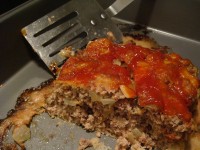 The French call it pate, and it sounds so much nicer! But plain old American meatloaf should not be looked down on. It’s great for dinner, but also for lunch, in a sandwich on buttered bread with extra ketchup. Use a standard 9 by 12 baking pan even for this small amount–you don’t want the meatloaf swimming in its own grease.
The French call it pate, and it sounds so much nicer! But plain old American meatloaf should not be looked down on. It’s great for dinner, but also for lunch, in a sandwich on buttered bread with extra ketchup. Use a standard 9 by 12 baking pan even for this small amount–you don’t want the meatloaf swimming in its own grease.
Serves 2 with leftovers
2 slices bacon (optional)
Olive oil
Butter
1 small onion
2 small cloves garlic
1 egg
heaping 1/2 cup bread crumbs (see note)
Large pinch dried thyme
2 dashes Worcestershire sauce
1 teaspoon Dijon mustard
Big pinch salt
Black pepper
1 tablespoon yogurt or milk
1 pound mix of ground pork, veal and beef (or all beef)
For optional glaze:
2 tablespoons ketchup
1 teaspoon brown sugar
1 teaspoon cider or red-wine vinegar
Preheat oven to 350 degrees.
If using the bacon, cook it over low heat in a heavy skillet until about halfway done–it should not be crispy. Remove it from the pan and set aside.
Chop onions in small pieces, and slice the garlic fine. Set the skillet (can be the same one you did the bacon in, and you don’t even need to clean it out) over medium-high heat and add a small glug of olive oil and about half a tablespoon of butter. When it’s warm, add the onions and garlic and cook until the onions are translucent and the garlic is fragrant, just a couple of minutes. Turn off the heat.
In a medium bowl, combine the egg, bread crumbs, thyme, Worcestershire sauce and mustard. Add a large pinch of salt and a couple of grinds of black pepper. Whisk in the yogurt or milk with a fork, and stir everything well. Add the meat and stir with a fork, combining everything well but not working the meat too aggressively. If the meat is sticking to the sides of the bowl, add another tablespoon of milk or yogurt. Finally, stir in the onions and garlic.
Place the meat in a baking pan, shaping it by hand or with a spoon into an even loaf shape, only about 1 1/2 inches thick.
Whisk together the ingredients for the glaze, then spoon this evenly over the top of the meatloaf. If you’re using the bacon slices, lay them over the top of the meatloaf. Place the pan in the oven and bake for 45 minutes or so, until the glaze is dark and bubbly and the meat is cooked through (160 degrees on a meat thermometer). Let rest about 10 minutes before serving.
Note: For bread crumbs, one of the best options is Japanese panko, because they’re both crunchy and fluffy. You can also make bread crumbs yourself, by whizzing a slice or two of bread up in the blender (tear it into a few pieces first), then optionally laying them out on a baking sheet and toasting them for about 10 minutes in the oven to dry them out. Store-bought bread crumbs are not ideal, as they tend to yield a gummier texture, but they’re not a disaster. You can also crush up a bunch of saltine crackers. If you need a gluten-free binder, quinoa sounds totally crunchy-granola, but is actually pretty good–it needs to be cooked before adding to the recipe, and use a bit less.
Pan-Roasted Half-Potatoes
 These delicate little potato halves are a neat trick, creating a texture that’s crispy on the outside and fluffy within. They don’t take much effort at all (except for peeling the potatoes), but they have a slightly fancy appearance.
These delicate little potato halves are a neat trick, creating a texture that’s crispy on the outside and fluffy within. They don’t take much effort at all (except for peeling the potatoes), but they have a slightly fancy appearance.
For 2 servings
2 medium baking potatoes
Butter
Salt
Pepper (optional)
 Preheat oven to 350 degrees. Peel your potatoes and slice them in half lengthwise on the wider axis, so the potato halves will be as flat as possible. Toss half a tablespoon of butter in a heavy baking pan (metal yields browner potatoes than Pyrex; a cast iron skillet is good too) and slide the pan in the oven to let the butter melt. When it’s foaming and sizzling, pull it out and add the potatoes: Coat them on both sides with the butter, then set them in the pan cut-side down (as at left). Sprinkle with salt, and grind over a bit of salt if you like.
Preheat oven to 350 degrees. Peel your potatoes and slice them in half lengthwise on the wider axis, so the potato halves will be as flat as possible. Toss half a tablespoon of butter in a heavy baking pan (metal yields browner potatoes than Pyrex; a cast iron skillet is good too) and slide the pan in the oven to let the butter melt. When it’s foaming and sizzling, pull it out and add the potatoes: Coat them on both sides with the butter, then set them in the pan cut-side down (as at left). Sprinkle with salt, and grind over a bit of salt if you like.
Bake until the undersides are nicely brown and the insides are fluffy, usually about 45 minutes. Serve with the pretty browned cut side facing up, poked open with a knife and with an additional dab of butter, if you like.
Pan-Fried Dandelion Greens with Cheese
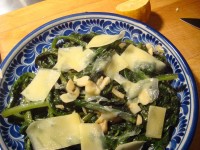 This uses the same technique as the Wilted Arugula in Episode 15, but takes a couple of minutes longer to cook because the dandelions are tougher. When buying greens, look for those labeled “sweet”–they’re not actually sweet, just less bitter than the standard dandelion greens; you want the ones that a bright green, not dark green, and avoid ones with reddish stems (these are so bitter that they must be boiled first). If you can’t find dandelions, use escarole instead.
This uses the same technique as the Wilted Arugula in Episode 15, but takes a couple of minutes longer to cook because the dandelions are tougher. When buying greens, look for those labeled “sweet”–they’re not actually sweet, just less bitter than the standard dandelion greens; you want the ones that a bright green, not dark green, and avoid ones with reddish stems (these are so bitter that they must be boiled first). If you can’t find dandelions, use escarole instead.
Serves 2 generously
Half bunch of “sweet” dandelion greens
3 medium cloves garlic
Olive oil
Salt
Gruyere, sharp white cheddar or parmesan
Half a lemon
Rinse greens thoroughly in several batches of cold water; no need to dry. Chop garlic coarsely.
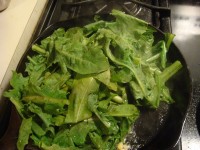 Set a heavy skillet over high heat and add a glug of olive oil. When it shimmers, toss in the garlic and stir just until fragrant. Add about half the greens (stand back, as the oil may spatter), stir briefly and put a lid on the skillet. After about 30 seconds, take the lid off and add the remaining greens, stirring a bit; add a pinch of salt. If the pan is looking dry, add a couple of tabelspoons more water. Put the lid back on and cook for another 4 to 5 minutes, stirring occasionally.
Set a heavy skillet over high heat and add a glug of olive oil. When it shimmers, toss in the garlic and stir just until fragrant. Add about half the greens (stand back, as the oil may spatter), stir briefly and put a lid on the skillet. After about 30 seconds, take the lid off and add the remaining greens, stirring a bit; add a pinch of salt. If the pan is looking dry, add a couple of tabelspoons more water. Put the lid back on and cook for another 4 to 5 minutes, stirring occasionally.
While the greens are cooking, cut your gruyere or cheddar into paper-thin slices, or grate your parmesan. When the greens are tender (check the stems), remove them from the heat and arrange in a shallow pile on a plate. Squeeze a bit of lemon juice over, then lay the cheese slices over the hot greens and serve immediately. (If you’re using grated parmesan, you have a bit more leeway, as this cheese doesn’t congeal when cool, and the greens themselves are fine even when they’re not piping hot.)


